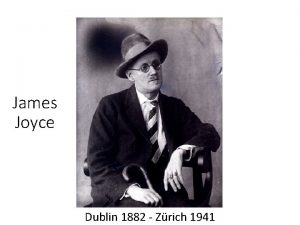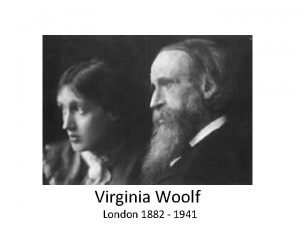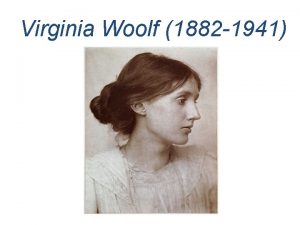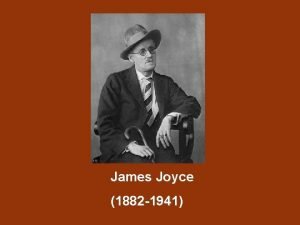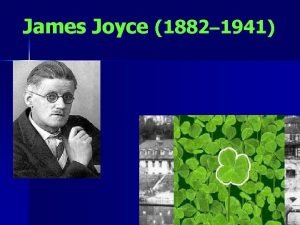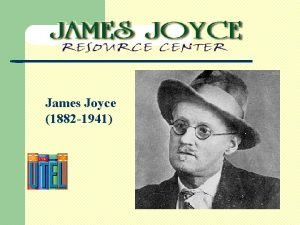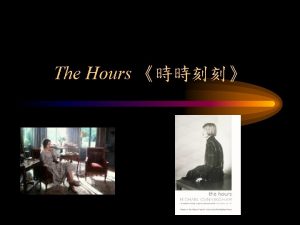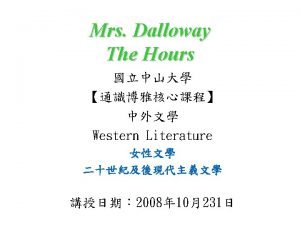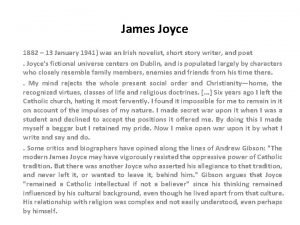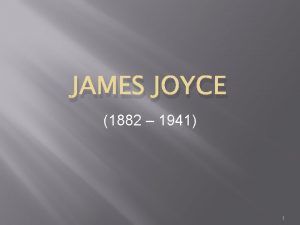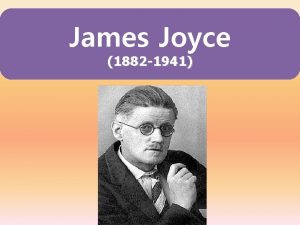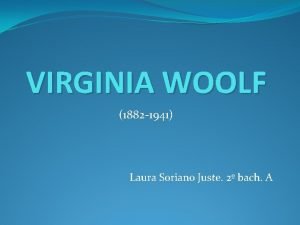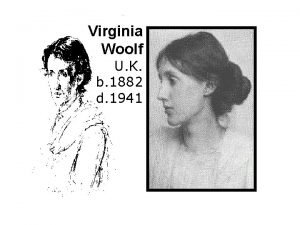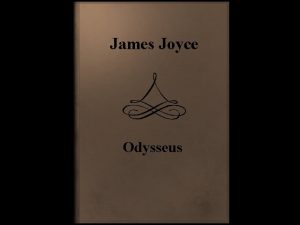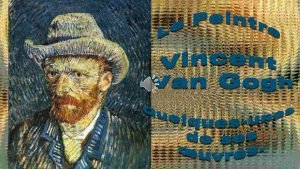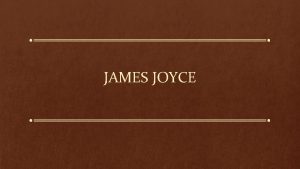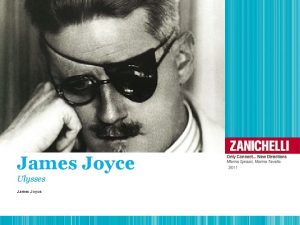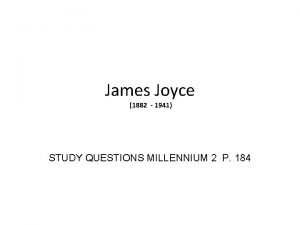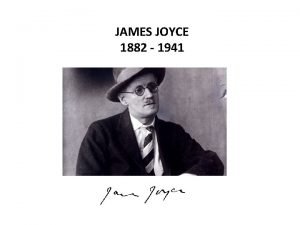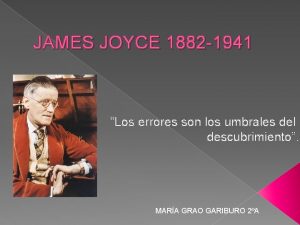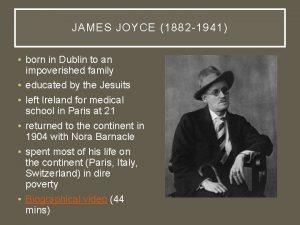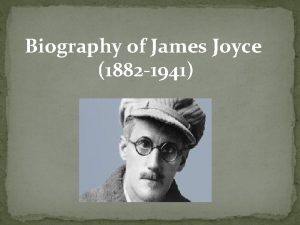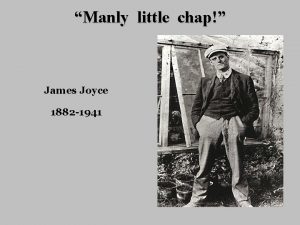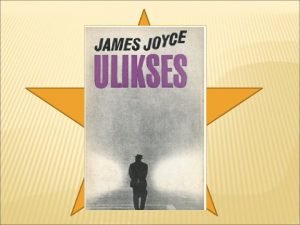James Augustine Aloysius Joyce 1882 1941 James Joyce






















- Slides: 22

James Augustine Aloysius Joyce (1882 -1941) James Joyce was born in Dublin in 1882. His father is , John Stanislaus Joyce, Joyce's mother is Mary Jane Murray. From the age of six Joyce, was educated by Jesuits at Clongowes Wood College, at Clane, and then at Belvedere College in Dublin (1893 -97). Later the author thanked Jesuits for teaching him to think straight, although he rejected their religious instructions.

At school he once broke his glasses and was unable to do his lessons. This episode was recounted in A PORTRAIT OF THE ARTIST AS A YOUNG MAN (1916). In 1898 he entered the University College, Dublin, where he found his early inspirations from the works of Henrik Ibsen, St. Thomas Aquinas and W. B. Yeats. Joyce's first publication was an essay on Ibsen's play When We Dead Awaken. It appeared in Fortnightly Review in 1900. At this time he began writing lyric poems.

After graduation the twenty-year-old Joyce went to Paris in 1902, he left Dublin forever and spent the rest of his life in Europe, first in Trieste with Nora Barnacle (by whom he had a son and daughter although they were not married until 1931) and later in Zurich (1915) and Paris (after the First World War). Joyce supported himself by teaching, but it was a constant struggle against poverty and illness.

CHAMBER MUSIC Joyce's first book was Chamber Music (1907), a sequence of thirty-six poems heavily romantic in feeling and traditional in style. Within their limited intentions, they were quite skillful and often beautiful, and have-unsurprisingly, given their manner and their title—been frequently set to music.

They reflect the influence of Elizabethan lyricists and the English lyric poets of the 1890 s. They also reflect Joyce’s love of the vocal music that influenced all his writing, and is especially evident in his later works that lend themselves particularly well to being read aloud. Although he had rejected Dublin and Catholicism, both were central to his writing.

-Major Works. Dubliners is a collection of 15 short stories by James Joyce, first published in 1914. They were meant to be a naturalistic depiction of the Irish middle class life in and around Dublin in the early years of the 20 th century.

Dubliners The stories centre on Joyce's idea of an epiphany: a moment where a character has a special moment of self-understanding or illumination. Many of the characters in Dubliners later appear in minor roles in Joyce's novel Ulysses. The initial stories in the collection are narrated by children as protagonists, and as the stories continue, they deal with the lives and concerns of progressively older people. This is in line with Joyce's tripartite division of the collection into childhood, adolescence and maturity.

"But when the restraining influence of the school was at a distance I began to hunger again for wild sensations, for the escape which those chronicles of disorder alone seemed to offer me. The mimic warfare of the evening became at last as wearisome to me as the routine of school in the morning because I wanted real adventures to happen to myself. But real adventures, I reflected, do not happen to people who remain at home: they must be sought abroad. " (from Dubliners)


A PORTRAIT OF THE ARTIST AS A YOUNG MAN This is James Joyce’s first novel, the semi-autobiographical story of a young Irish boy who struggles with family, country, and religion to become an artist and a man.

It was a fictional rendering of Joyce's youth, but he eventually grew frustrated with its direction and abandoned this work. It was never published in this form, but years later, in Trieste, Joyce completely rewrote it as A Portrait of the Artist as a Young Man. The unfinished Stephen Hero was published after his death.

The book follows the life of the protagonist, Stephen Dedalus, from childhood towards maturity, his education at University College, Dublin, and rebellion to free himself from the claims of family and Irish nationalism. Stephen takes religion seriously, and considers entering a seminary, but then also rejects Roman Catholicism. At the end Stephen resolves to leave Ireland for Paris to encounter "the reality of experience”.

His stylistic virtuosity was already evident : in the book we see the prose style develop along with Stephen, from what is really babytalk in the opening paragraphs, to the “lucid supple periodic prose” of the end of the book.

"– Look here, Cranly, he said. You have asked me what I would do and what I would not do. I will tell you what I will do and what I will not do. I will not serve that in which I no longer believe, whether it call itself my home, my fatherland, or my church: and I will try to express myself in some mode of life or art as freely as I can and as wholly as I can, using my defence the only arms I allow myself to use – silence, exile, and cunning. " (from A Portrait of the Artist as a Young Man)

Ulysses The title alludes to Odysseus (Latinised into Ulysses), the hero of Homer's Odyssey, and establishes a series of parallels between characters and events in Homer's poem and Joyce's novel e. g. , the correspondence of Leopold Bloom to Odysseus, Molly Bloom to Penelope, Stephen Dedalus to Telemachus.

Ulysses which came out in 1922, the same year as Eliot’s The Waste Land, was more brilliant, but also deeply shocking containing explicit descriptions of sex and other bodily functions and a profusion of different styles ( at least one for each of the nineteen chapters), other features were its incredibly complex formal structure ( which critics might never have noticed had Joyce not made explicit statements about it )

The main character is Leopold Bloom, in the story, using stream-ofconsciousness technique, parallel the major events in Odysseus' journey home. However, Bloom's adventures are less heroic and his homecoming is less violent. Bloom makes his trip to the underworld by attending a funeral at Glasnevin Cemetary

Structure : Joyce divided Ulysses into eighteen chapters or "episodes". At first glance much of the book may appear unstructured and chaotic; Joyce once said that he had "put in so many enigmas and puzzles that it will keep the professors busy for centuries arguing over what I meant", which would earn the novel "immortality". Every episode of Ulysses has a theme, technique, and correspondences between its characters and those of the Odyssey.

Finnegans Wake is a work of comic fiction , significant for its experimental style and resulting reputation as one of the most difficult works of fiction in the English language. Written in Paris over a period of seventeen years, and published in 1939, two years before the author's death, Finnegans Wake was Joyce's final work.

It is partly based on Freud's dream psychology, Bruno's theory of the complementary but conflicting nature of opposites, and the cyclic theory of history of Giambattista Vico (1668 -1744). There is not much plot or characters to speak of – the life of all human experience is viewed as fragmentary. Some critics considered the work masterpiece, though many readers found it incomprehensible.

Finnegans Wake , which may be interpreted as a dream containing the whole of human history , full of puns in twenty different languages and written in a kind of English which is barely recognizable as such , since every word is loaded with multilingual resonances and allusions.

Joyce’s humanity and humour triumph everywhere in his fiction, and his constant combination of the vulgar and the refined , the sublime and the ridiculous, has made him perhaps the greatest novelist of this century. On January 13, 1941, James Joyce died of a stomach ulcer at the age of 58, and was buried in Zurich's Fluntern Cemetery.
 Giorgio joyce
Giorgio joyce 1941-1882
1941-1882 1941-1882
1941-1882 Leslie stephen virginia woolf
Leslie stephen virginia woolf James joyce birthplace
James joyce birthplace 1941-1882
1941-1882 1941-1882
1941-1882 Mrs dalloway summary
Mrs dalloway summary 1941
1941 1941-1882
1941-1882 1882-1941
1882-1941 1941-1882
1941-1882 1941-1882
1941-1882 1941-1882
1941-1882 1941-1882
1941-1882 1941-1882
1941-1882 štěpán dedalus
štěpán dedalus Magister aloysius
Magister aloysius Shon augustine
Shon augustine Aot 1
Aot 1 St augustine school cambridge
St augustine school cambridge Wo wird einst des wandermüden letzte ruhestätte sein
Wo wird einst des wandermüden letzte ruhestätte sein Noah augustine
Noah augustine

